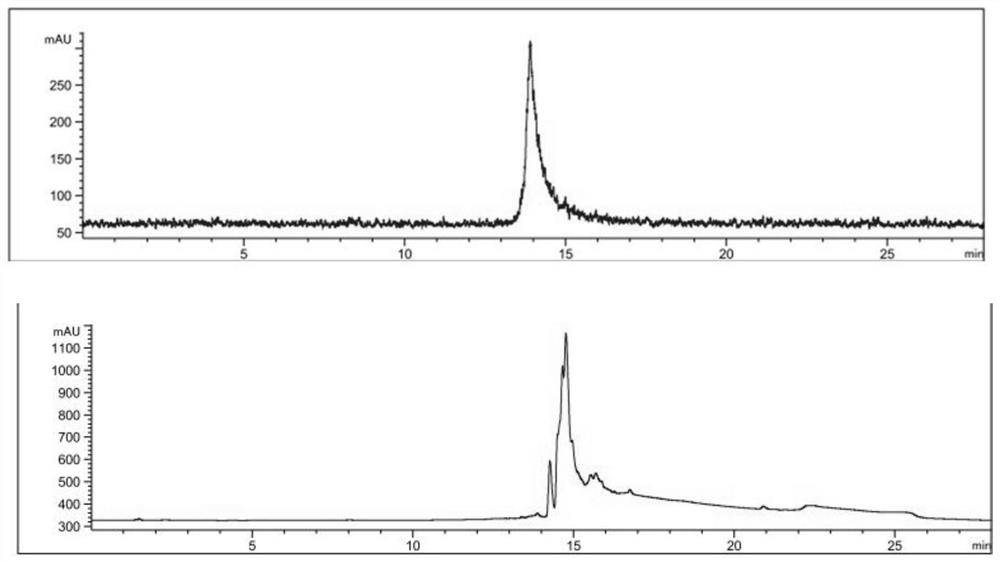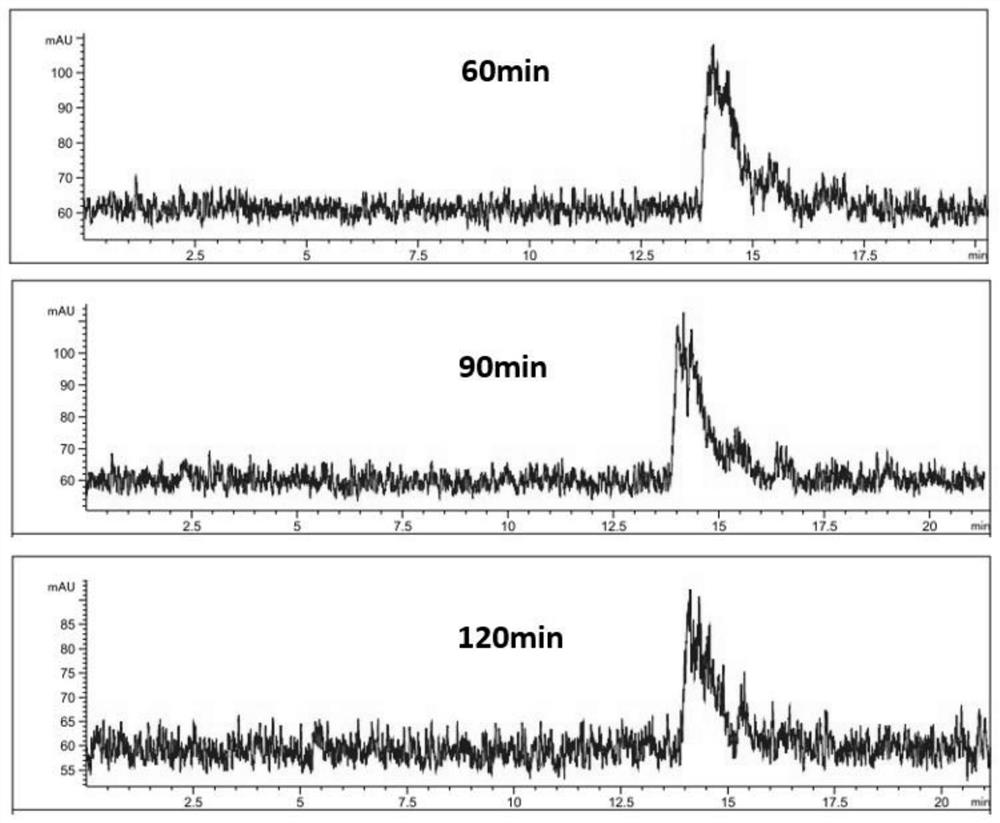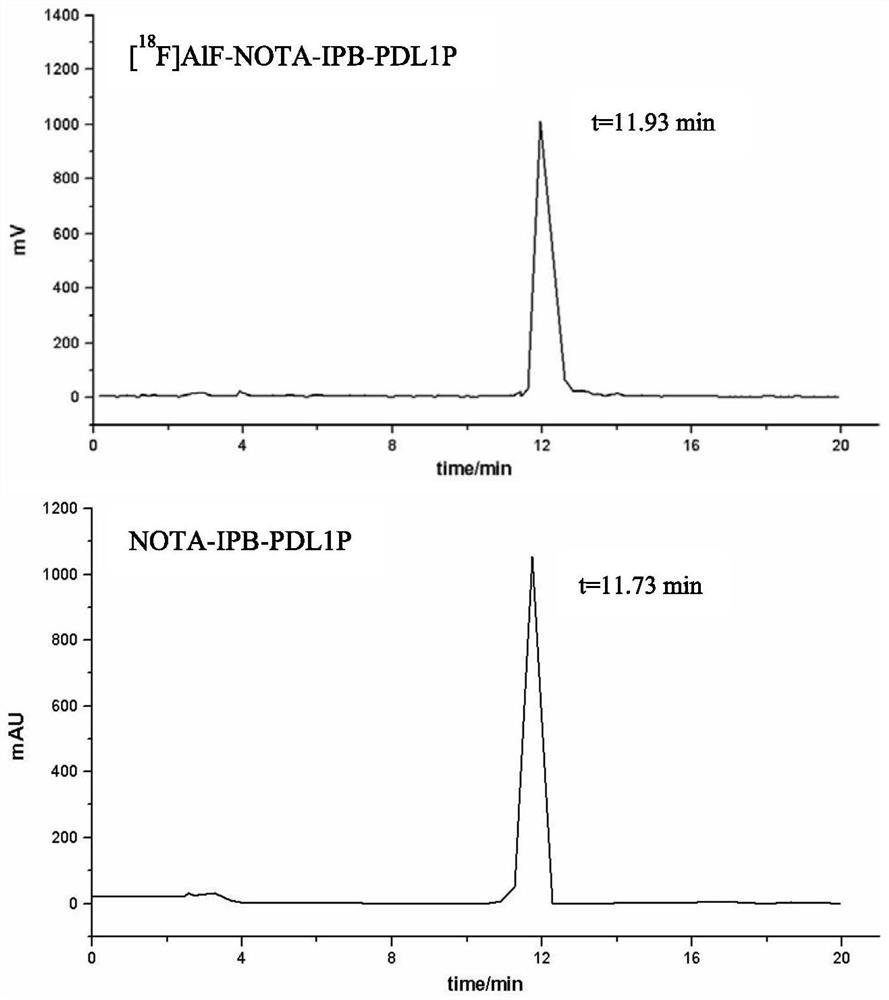Targeting PD-L1 polypeptide probe and application thereof in preparation of PET imaging agent
A PD-L1, targeting technology, applied in the field of application, preparation, and targeting of PD-L1 polypeptide probes in tumor positron emission tomography imaging agents, can solve the problem of no in vivo imaging research reports, labeling difficulties, in vivo Clearing slow and other issues
- Summary
- Abstract
- Description
- Claims
- Application Information
AI Technical Summary
Problems solved by technology
Method used
Image
Examples
Embodiment 1
[0056] Example 1 Preparation of precursor NOTA-R-PDL1P
[0057]PDL1P was prepared by solid-phase peptide synthesis. After PDL1P was prepared by solid-phase peptide synthesis, it was reacted with L-lysine-BOC in basic dimethyl sulfoxide to generate PDL1P-Lys-BOC. PDL1P-Lys-BOC reacts with R-OH (R=4-methylphenylbutyryl or 4-iodophenylbutyryl) to form PDL1P-R-Lys-BOC, after removing the protecting group-BOC, it contains diisopropyl The primary product NOTA-R-PDL1P (R=4-methylphenylbutyryl or 4-iodophenylbutyryl) is obtained by reacting with p-SCN-Bn-NOTA in the slightly alkaline solution of ethylamine in dimethyl sulfoxide. . After removing the protecting group-BOC from PDL1P-Lys-BOC, it was then reacted with p-SCN-Bn-NOTA in a slightly alkaline solution containing diisopropylethylamine in dimethyl sulfoxide to obtain the primary product NOTA-R-PDL1P(R =-H). The initial product was separated and purified by preparative HPLC to collect the product peak, and after freeze-drying...
Embodiment 218
[0060] Example 2 [ 18 Radiosynthesis of F]AlF-NOTA-R-PDL1P
[0061] In the reaction flask filled with NOTA-R-PDL1P (R=H, 4-methylphenylbutyryl, or 4-iodophenylbutyryl) (50 μg / μL, 50 μL), 2 mM AlCl was added sequentially 3 Solution 6 μL, glacial acetic acid 4 μL and acetonitrile 300 μL, mix well. passed by the cyclotron 18 O(p,n) 18 F nuclear reaction produced 18 F - , in N 2 Under the carrier band, trapped in the Sep-Pak QMA anion cartridge, 18 O-water is collected in recycling bottles. Fill the QMA cartridge with 0.3-0.4 mL of normal saline. 18 F-eluted into a vial, and 50-100 μL of it was added to the above reaction vial. After stirring and mixing, the reaction was heated at 100°C for about 10 to 15 minutes. Cool, add 6-8 mL of water to the reaction flask, mix well, and transfer to HLB cartridge or SEP-PAK C18 cartridge. After all the solution in the reaction bottle was transferred, rinse the cartridge with 10 mL×3 water for injection, and blow dry the cartridge. ...
Embodiment 368
[0062] Example 3 [ 68 Ga]NOTA-R-PDL1P and [ 64 Radiosynthesis of Cu]NOTA-R-PDL1P
[0063] In a reaction tube containing 50 μL of the precursor NOTA-R-PDL1P (R=H, 4-methylphenylbutyryl, or 4-iodophenylbutyryl) (50 μg / μL), 200 μL of 1.25 M sodium acetate solution was added. from 68 Ge / 68 The Ga generator was eluted with 4 mL of 0.05M hydrochloric acid 68 GaCl 3 Put it into the above reaction tube, mix well, adjust the pH of the solution to 4.0, and heat at 100°C for about 10-15 minutes. Cool, add 4 mL of physiological saline to the reaction flask, mix well, and transfer to HLB cartridge or SEP-PAK C18 cartridge. After all the solution in the reaction bottle was transferred, rinse the small column with 10 mL×2 water for injection, and blow dry the small column. Then, the product was eluted with 1.5 mL of ethanol and collected into a receiving bottle after passing through a sterile filter. It was diluted with physiological saline into a product solution containing 5% ethan...
PUM
 Login to View More
Login to View More Abstract
Description
Claims
Application Information
 Login to View More
Login to View More - R&D Engineer
- R&D Manager
- IP Professional
- Industry Leading Data Capabilities
- Powerful AI technology
- Patent DNA Extraction
Browse by: Latest US Patents, China's latest patents, Technical Efficacy Thesaurus, Application Domain, Technology Topic, Popular Technical Reports.
© 2024 PatSnap. All rights reserved.Legal|Privacy policy|Modern Slavery Act Transparency Statement|Sitemap|About US| Contact US: help@patsnap.com










